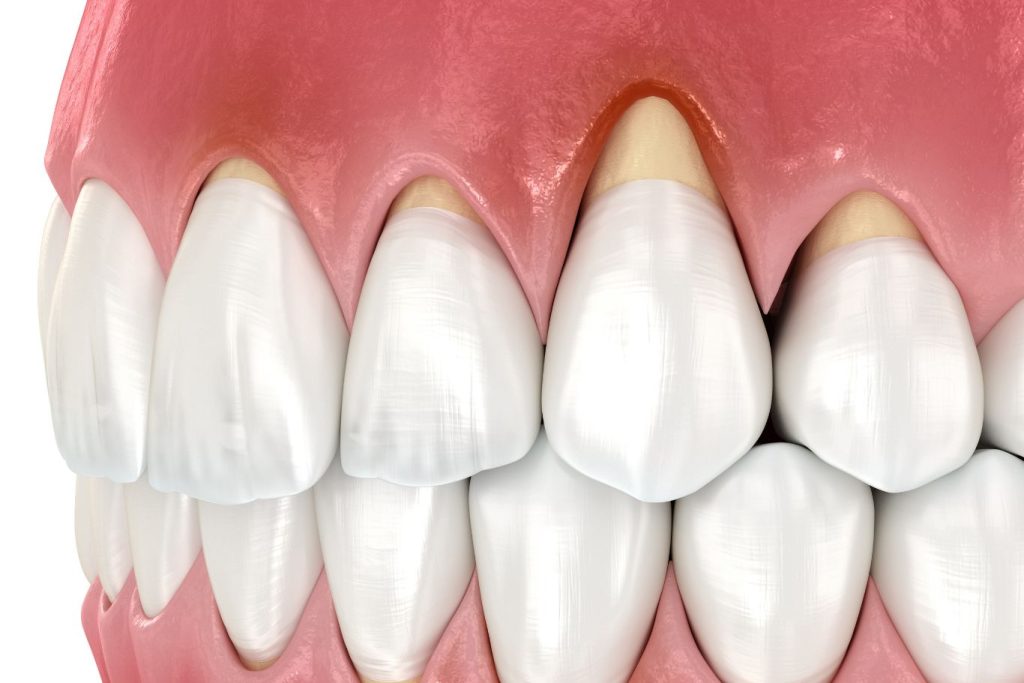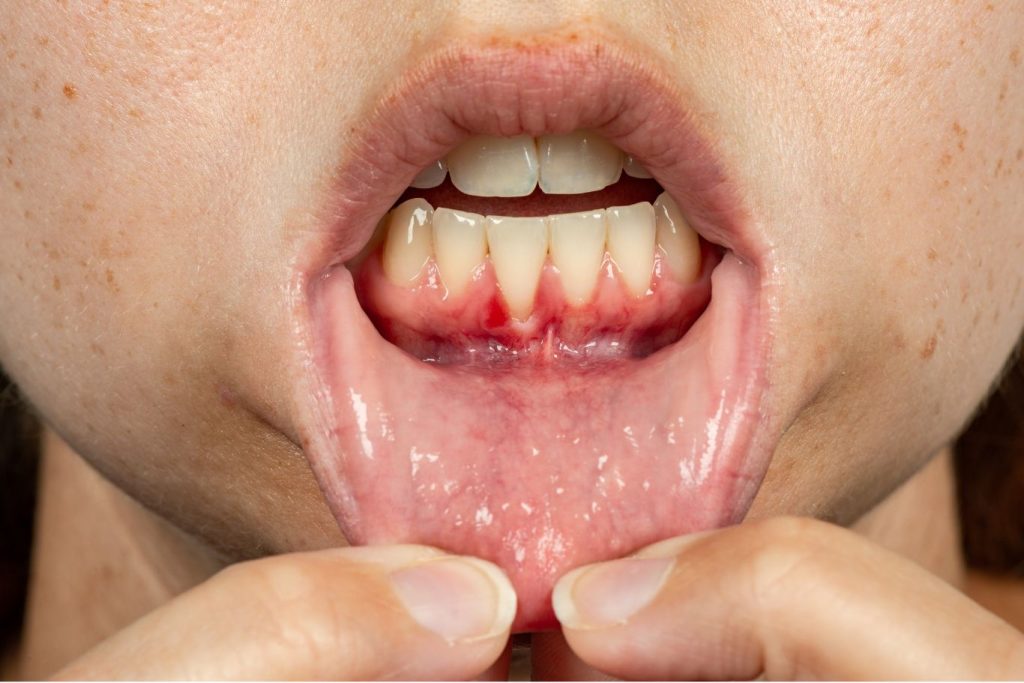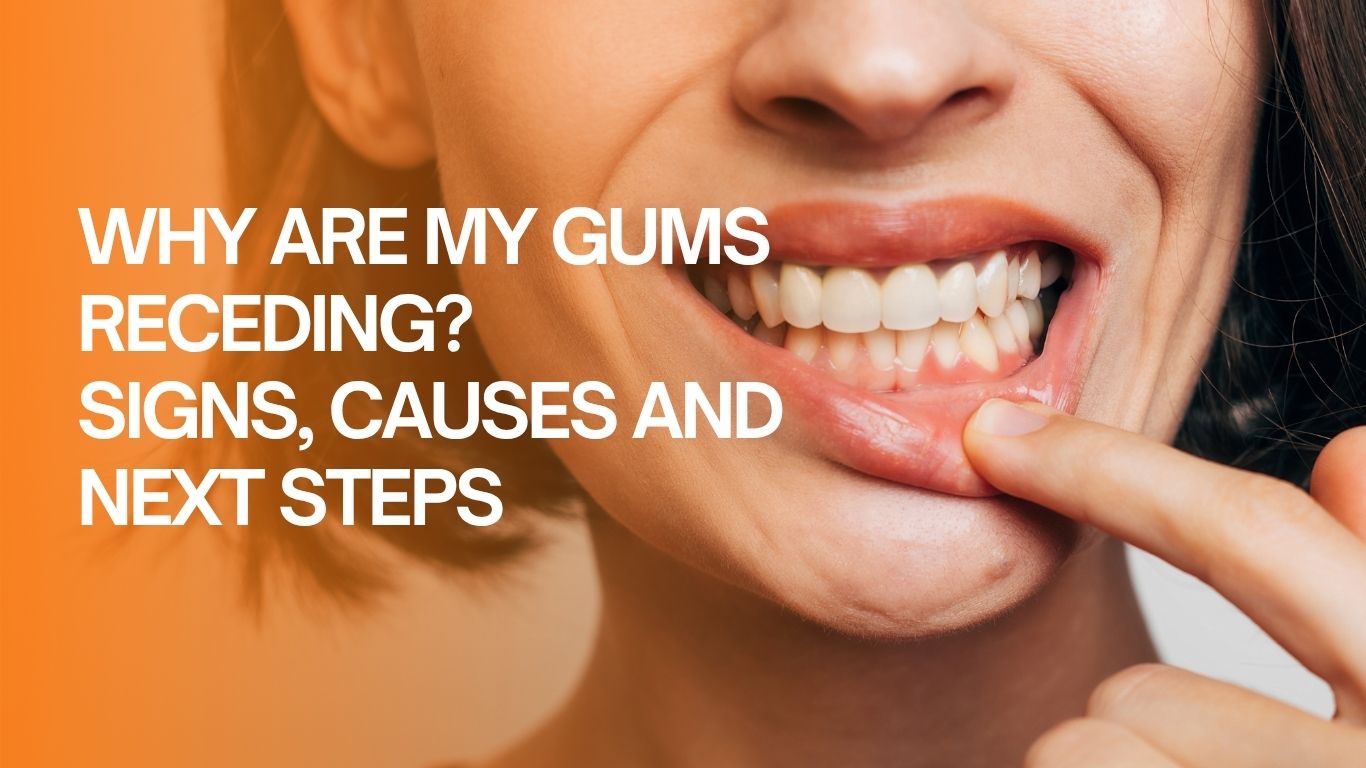You may have looked in the mirror and noticed that your teeth appear longer than before – and wondered why. If so, you might be experiencing the early signs of gum recession, a common condition that affects many adults. Although it often develops gradually, gum recession shouldn’t be ignored – it can lead to tooth sensitivity, aesthetic changes, and even more serious oral health issues if left untreated.
In this article, we’ll explore what causes your gums to recede, the key signs to watch for, and the most effective ways to prevent and treat it. Understanding the underlying factors and acting early can help you protect your gums and maintain a healthy smile.
What are receding gums?
Let’s start by understanding what receding gums actually are. Gum recession (or gingival recession, in medical terms) occurs when the gum tissue pulls away from the teeth, exposing the tooth roots. As a result, your teeth may become more sensitive to temperature changes and brushing.
A dentist or periodontist can assess the level of recession – mild, moderate, or severe – depending on how much of the tooth root is exposed. Gum recession may affect a single tooth or several teeth.
While it’s often associated with poor oral hygiene, that’s not always the case. Gum recession can have multiple causes, which we’ll explore below.

What causes your gums to recede?
Gum recession can affect anyone, even those who brush and floss regularly. However, research has identified several contributing factors, including poor oral health:
- Poor oral health: Not brushing or flossing regularly can cause plaque to build up on your teeth and gums, leading to inflammation, gum disease, and gum recession.
- Aggressive brushing or flossing: Applying too much pressure when brushing or flossing can damage your gums.
- Hormonal changes: Pregnancy, menopause, and hormonal fluctuations can make gums more sensitive and prone to recession.
- Genetics: Some people naturally have thinner or more fragile gum tissue.
- Misaligned teeth: Crooked or crowded teeth can place uneven pressure on the gums, causing them to recede.
- Teeth grinding or clenching (bruxism): This usually occurs at night while sleeping.
- Gum or tooth trauma: Injuries to the gums or teeth can lead to local recession.
- Tobacco: Smoking and vaping are directly linked to receding gums.
Signs of receding gums to look out for

The most obvious sign of gum recession is gums that appear to shrink away from the teeth. Teeth may look longer, and the exposed root surfaces can appear darker than the crown. You might also notice a visible line or “notch” between the crown and root.
Other symptoms you may notice include:
- Sensitivity to hot, cold, or sweet foods and drinks
- Red, swollen, or sore gums. If you notice dark red gums around your teeth, this may indicate early gum inflammation or infection
- Bleeding gums when brushing or flossing
- Bad breath
- Pain when chewing
- Loose or shifting teeth
Available treatments for receding gums
If gum recession is left untreated, it can worsen over time, potentially leading to bone loss. Your dentist will recommend the best gum disease treatment based on the cause and severity of your recession.
Non-surgical gum recession treatments
If overbrushing or improper flossing is the issue, your dentist can advise you on gentle, effective cleaning techniques.
In cases related to gum disease, a deep cleaning – also known as scaling and root planning – may be recommended. This involves removing plaque and bacteria from below the gumline and smoothing the tooth roots to encourage the gums to reattach.
Surgical gum recession treatments
If your tooth roots are exposed and this is causing oral health issues or affecting your confidence, there are several surgical options available to restore the appearance and function of your gums. These include:
- Gum contouring. A periodontist will reshape the gum line with a scalpel or laser for a more even appearance.
- Gum grafting. Tissue is taken from another area of your mouth (or a donor) and placed over the recessed area. Recovery typically takes a week.
- Regeneration therapy. A more modern approach, this involves gently lifting the gum tissue and placing a bone graft or other regenerative material to restore lost bone. Regeneration therapy is typically used as a last resort to treat severe gum and bone tissue damage caused by periodontal disease.
In some cases, if gum recession has also exposed the root surface and affected the appearance of your teeth, your dentist might recommend dental bonding to cover exposed areas and improve aesthetics.
Can receding gums be reversed?
Unfortunately, gums cannot grow back naturally. However, while gums cannot regenerate, you can take proactive steps to protect them and prevent further damage.
Regular visits to a dentist or periodontist will help you receive personalized advice and treatment options to protect your smile.
Next steps: How to protect your gums
Healthy gums are essential for strong teeth and a confident smile. If you notice early signs of gum recession or swelling behind teeth gums, speak with your dentist as soon as possible – these issues are often detected during routine checkups.
Here’s what you can do:
- Consistent, gentle oral hygiene
- Brush twice daily with fluoride toothpaste.
- Floss once a day to remove plaque between teeth
- Use an antimicrobial or fluoride rinse if recommended.
- Quit smoking and avoid tobacco products
- Manage underlying health conditions
- Keep diabetes under control, as high blood sugar impairs healing
- Eat a balanced diet rich in vitamins C and D, calcium, and omega-3s to support gum health
- Protect your teeth from mechanical stress
- Wear a night guard if you grind or clench your teeth
- Correct misaligned teeth to reduce uneven gum pressure
- Choose the right dentist or periodontist for treatment
- Schedule regular dental visits: Professional cleanings and gum evaluations every six months allow dentists to catch recession early.
- Seek a specialist when necessary: If your gum recession is advanced, your dentist may refer you to a periodontist, a specialist trained in treating gum diseases and performing procedures such as grafting or scaling.
Protecting your gums is a long-term investment in your oral and overall health. With consistent daily care, regular dental checkups, and healthy lifestyle habits, you can stop gum recession from worsening and, in early stages, even helping your gums heal naturally.
Disclaimer:
This content is for informational purposes only and is not a substitute for professional dental advice, diagnosis, or treatment. Always consult with a qualified dental professional for personalized guidance.
Sources:
- Centers for Disease Control and Prevention (CDC) – Oral Health – About Periodontal (Gum) Disease
- The Journal of the American Dental Association – Gingival recession
- Oral Health Information from the ADA – Gum Disease
- National Institue of Dental and Craniofacial Research (NIDCR) – Gum (Periodontal) Disease
